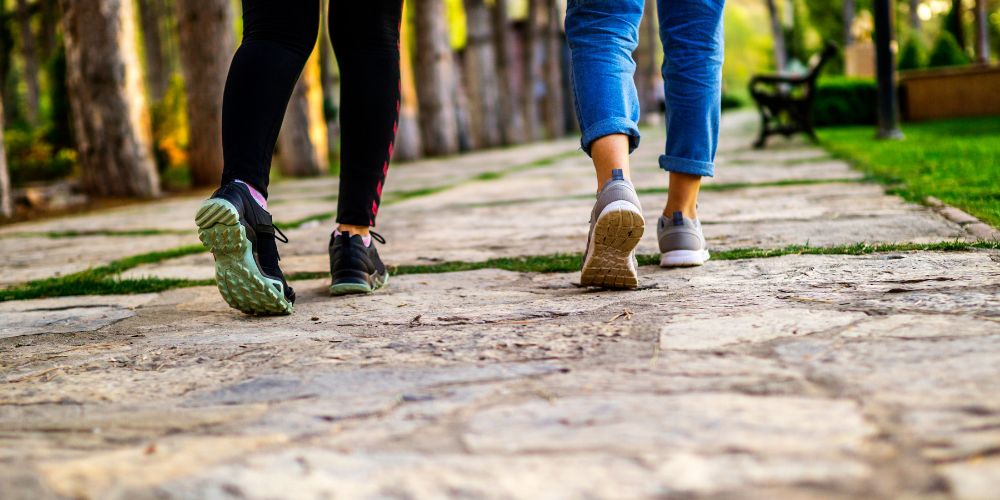Walking is an excellent activity for general health. It’s low-stress and requires minimal equipment other than a pair of shoes. But will walking help build muscle?
Walking doesn’t build muscle as it doesn’t satisfy the main mechanism of muscle hypertrophy, being mechanical tension. Mechanical tension is maximized through force generation and stretch, which walking provides little of.
This isn’t the only reason walking doesn’t build muscle. And how can walking benefit you if building muscle isn’t on the menu?
Table of Contents
Does Walking Build Muscle?
Walking doesn’t build muscle and shouldn’t be an exercise to try to do so. It provides minimal mechanical tension to the working muscles, which is vital for muscle growth [1][2][3]. To maximize tension, it requires high force generation under stretch.
This means lifting heavy loads through a full range of motion. But you can also build muscle with lighter loads, but you need to lift closer to failure or to failure to maximize mechanical tension [4].
Another indirect mechanism of muscle growth is metabolic stress, which is the build-up of by-products from energy production. This may reduce muscle atrophy when inactive and play a role in building muscle.
Walking doesn’t maximize either mechanism and, therefore, doesn’t build muscle. Even walking uphill isn’t enough resistance to build muscle.
Then we have molecular signaling from exercise. Endurance exercise, like brisk walking, signals the AMPK pathway responsible for endurance adaptations [5].
It’s the mTOR pathway that is responsible for stimulating the muscle-building response. The AMPK inhibits the mTOR pathway, lasts up to 3 hours, and is influenced by the intensity and volume of walking [5][6].
Does Walking Make Your Legs Bigger Or Smaller?

Walking in isolation when in a caloric deficit will make your legs smaller. But this is only because the legs aren’t stimulated with any muscle-building response.
Bodybuilders will use walking as their primary form of cardio for general health and during prep to create a caloric deficit without much stress.
Does that mean walking will make your legs big like a bodybuilder? Definitely not. They spend hours in the gym lifting weights to build the physique they have. Walking is a tool to help reduce body fat without having to reduce food intake too much.
Does Walking Build Calf Muscles?
Walking does not build the calf muscles to any significant degree. To get big calves, you need to significantly overload them since they support your body weight when walking all day. This means heavy standing and seated calf raises for high reps with a pause in the stretch position.
This pause dissipates elastic energy stored in the Achilles tendon as heat forces the calves to work harder when standing on their toes.
Does Walking Build Muscle Or Burn Fat?
Walking doesn’t build muscle or burn fat. No exercise inherently burns fat to any significant degree. Sure, hooked up to a machine measuring respiratory gas exchange ratio will show walking predominantly uses fat as fuel [7].
But the overall caloric burn is too small to make any meaningful impact to burn fat. Instead, to burn fat, you must reduce your caloric intake from food to place yourself in a caloric deficit. Walking can be part of this process to reduce the amount of food you need to cut.
As mentioned, bodybuilders use this tactic to consume more food while dropping body fat and maintaining muscle mass.
Summary
Walking won’t build muscle mass as there is little to no resistance. This means the force requirements from the legs are minimal. Instead, use walking as a tool for general health and help create a caloric deficit if your goal is to lose weight.
References
1. Schoenfeld, B. J. (2010). The mechanisms of muscle hypertrophy and their application to resistance training. The Journal of Strength & Conditioning Research, 24(10), 2857-2872.
2. Wackerhage, H., Schoenfeld, B. J., Hamilton, D. L., Lehti, M., & Hulmi, J. J. (2019). Stimuli and sensors that initiate skeletal muscle hypertrophy following resistance exercise. Journal of applied physiology.
3. Krzysztofik, M., Wilk, M., Wojdała, G., & Gołaś, A. (2019). Maximizing muscle hypertrophy: a systematic review of advanced resistance training techniques and methods. International journal of environmental research and public health, 16(24), 4897.
4. Schoenfeld, B. J., Grgic, J., Ogborn, D., & Krieger, J. W. (2017). Strength and hypertrophy adaptations between low-vs. high-load resistance training: a systematic review and meta-analysis. The Journal of Strength & Conditioning Research, 31(12), 3508-3523.
5. Methenitis, S. (2018). A brief review on concurrent training: from laboratory to the field. Sports, 6(4), 127.
6. Baar, K. (2014). Using molecular biology to maximize concurrent training. Sports Medicine, 44(2), 117-125.
7. Rothschild, J. A., Kilding, A. E., Stewart, T., & Plews, D. J. (2022). Factors influencing substrate oxidation during submaximal cycling: a modeling analysis. Sports Medicine, 52(11), 2775-2795.
